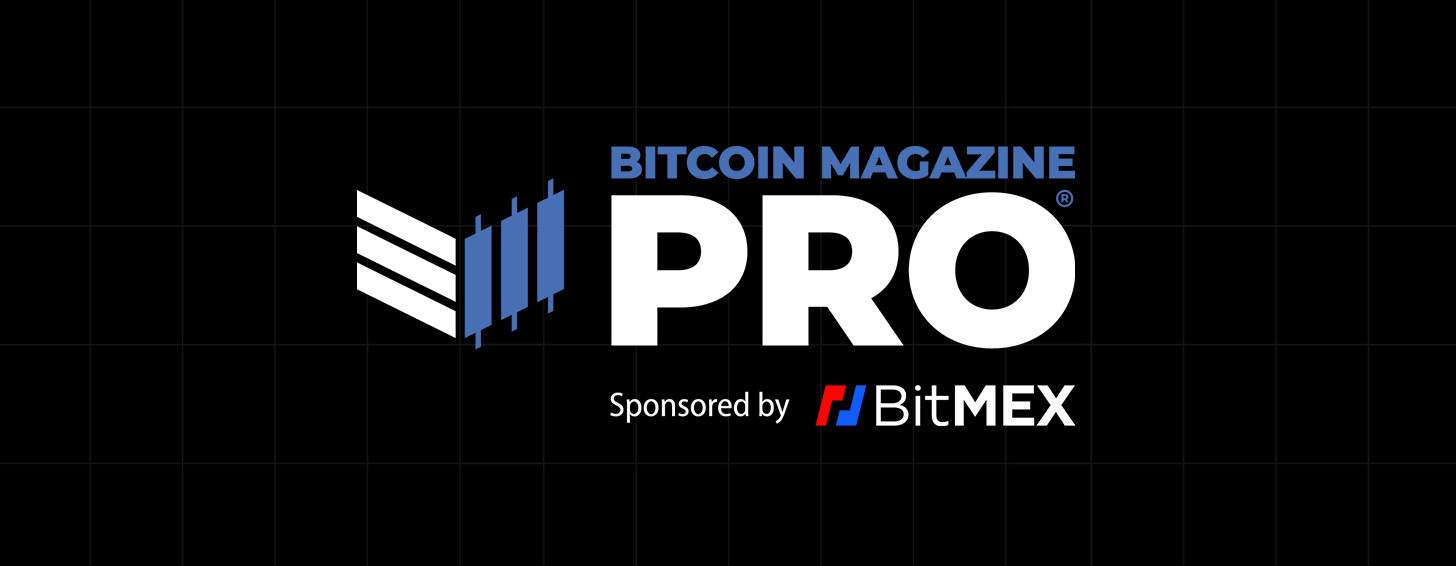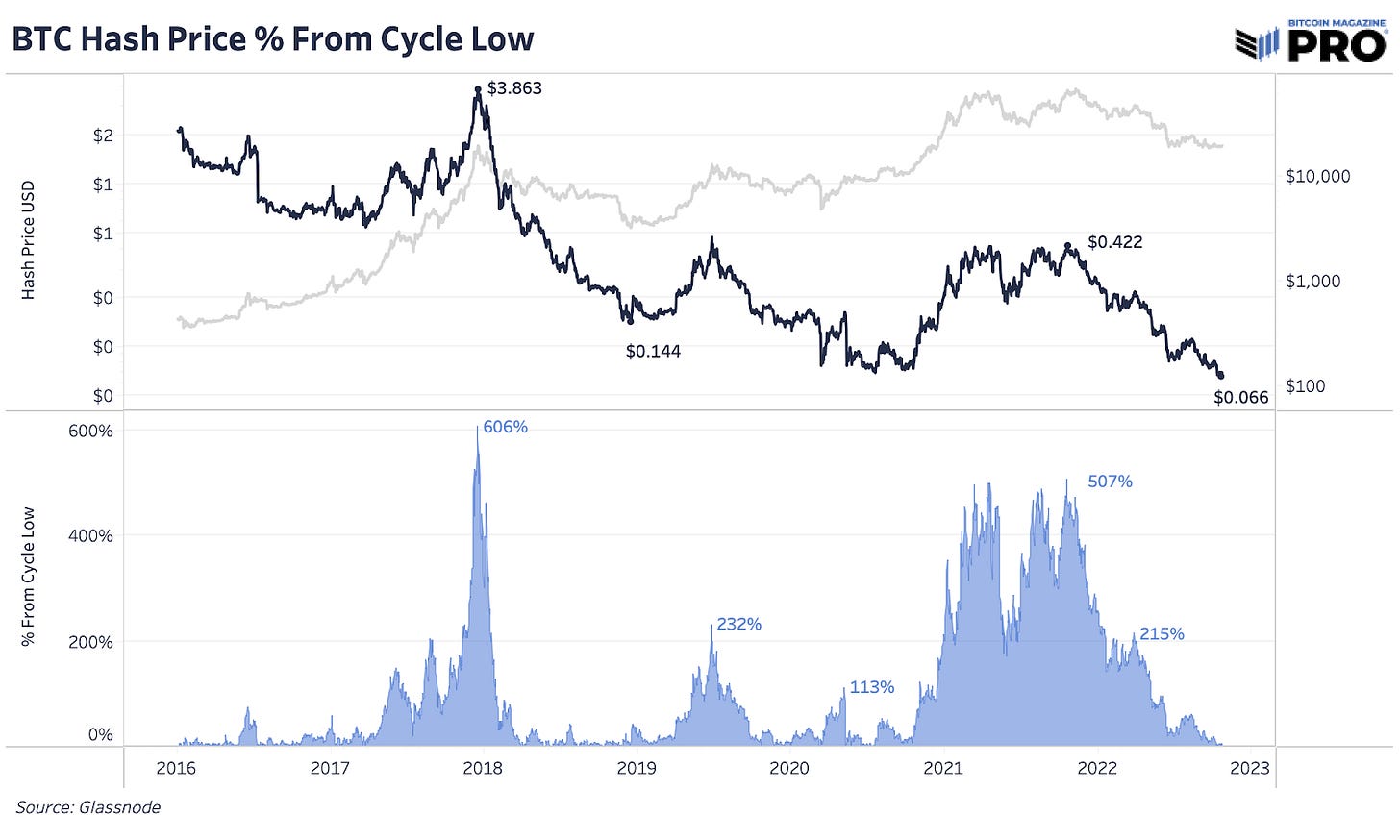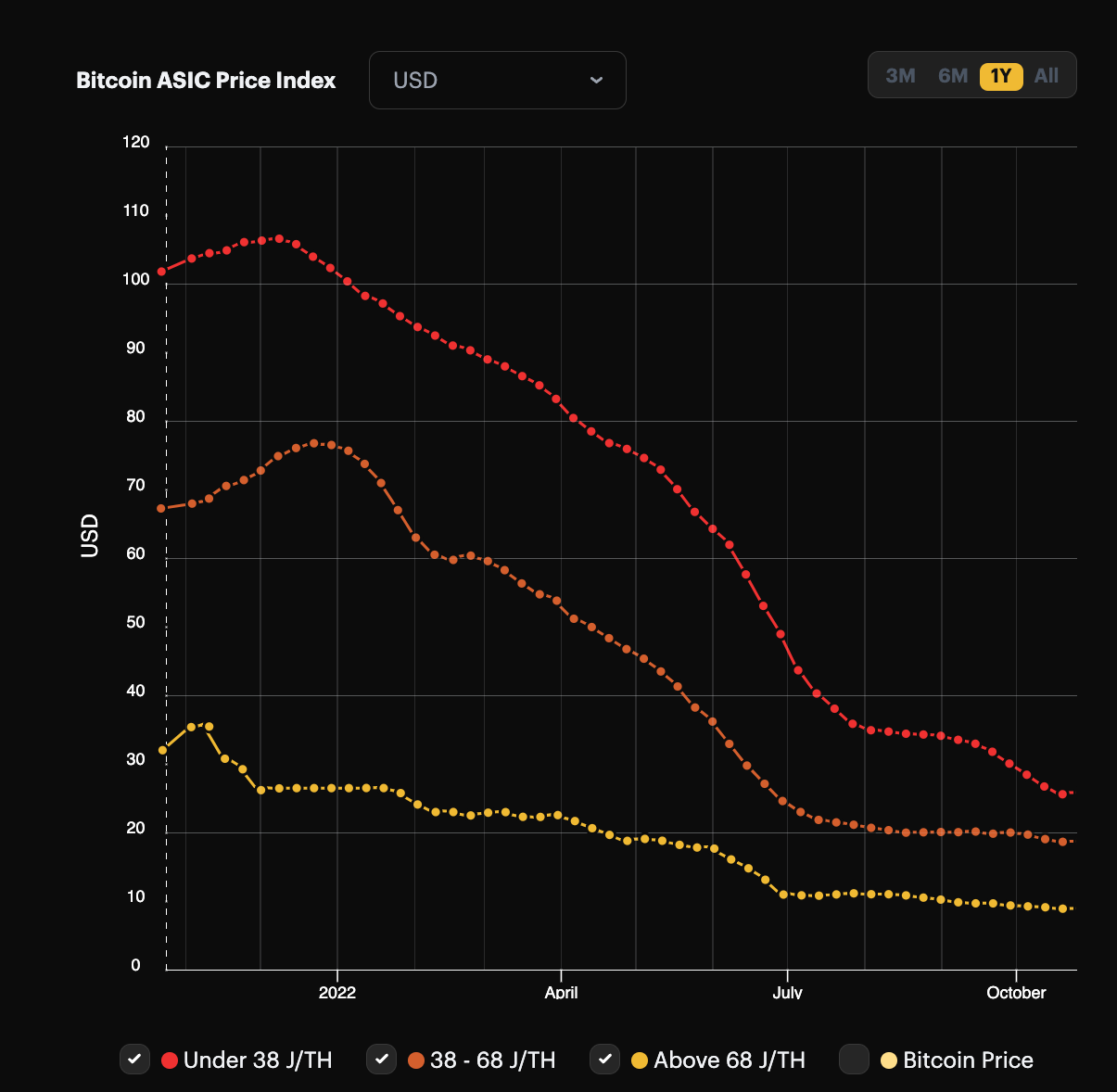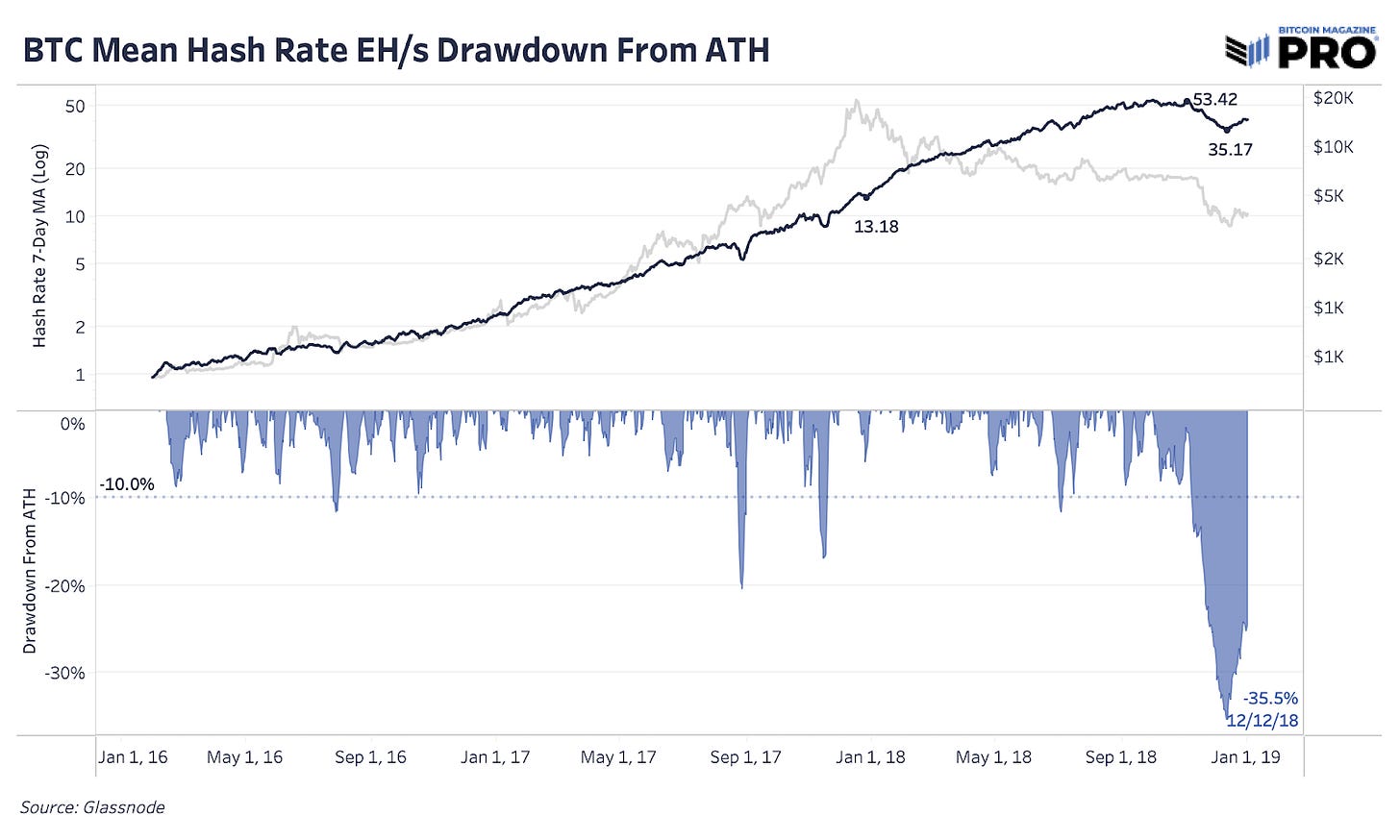This Time Isn’t Different: Miners Are Biggest Risk Facing Bitcoin Market In Repeat of 2018 Cycle
The Bitcoin mining industry faces intense pressure as hash price reaches new lows and the difficulty adjustment continues rising. We compare today’s mining situation to parallels from 2018.
Relevant Past Articles:
As Hash Rate Soars, Parallels to 2018 Arise
Over the weekend, bitcoin mining difficulty saw an upwards adjustment of 3.44% (after the previous adjustment of 13.55%), pushing mining difficulty to yet another all-time high as hash rate continues to soar. With the price of bitcoin stagnating at $20,000 give or take for the last few months, we have noticed some parallels between the market cycle of 2018 and the one in front of us today.
Meme Source: Braiins Mining
First off, we will link to some of our previous issues on the mining industry above, and reintroduce our bitcoin mining investment framework - which is a simple yet elegant tool for investors to evaluate whether bitcoin mining equities/infrastructure or bitcoin itself is (potentially) the better investment at any one point in time.
When is the optimal time to invest in publicly-traded bitcoin miners?
An extremely simply framework for investors is:
Hash price bull market = Bitcoin miners outperform bitcoin
Hash price bear market = Bitcoin miners underperform bitcoin
Hash price divides miner revenue by hash rate (daily miner revenue per 1 TH/s, as first coined by the team at Luxor).
With that in mind, the rising hash rate dynamic seen throughout 2022 while the bitcoin price has fallen has put a lot of pressure on both public and private mining operations. Throughout the year, we have seen public miners capitulate on their bitcoin holdings, as diminishing revenue and treasury values have placed increasing pressure on balance sheets.
At their peak, public miners' bitcoin holdings reached over 46,000 BTC but have since fallen 26% as bitcoin treasuries were sold out of necessity to access more capital, pay down debt and fund operations and expansion plans. Although estimated and rough numbers, the top public miners make up over 20% of all Bitcoin’s network hash rate. Moves from public miners to not only sell bitcoin holdings but also to expand and contract their hash rate have a significant impact on the market.


As hash price continues to trend to all time lows, the probability of a miner capitulation/liquidation event probabilistically increases until a drawdown in hash rate, as certain entities cease mining and liquidate their assets (in the form of both bitcoin and ASICs).
Barring the China mining ban during 2021, the largest peak-to-trough drop in hash rate (7d MA) in the history of bitcoin was approximately 35%. In our opinion, this bear market cycle won’t end until a flush of the weakest miner participants has occurred, which will be observable by a temporary yet meaningful fall in hash rate and will subsequently decrease mining difficulty, easing conditions for the surviving participants.
Click here to set your reminder for the Bitcoin Magazine PRO Twitter Spaces taking place Thu Oct 27 at 1:OO PM PT with special guest James Lavish.
While there was already a “capitulation” per se earlier this summer during the initial cryptocurrency market deleveraging in June, hash rate has since gone vertical, with new fleets of the newest Bitmain Antminer S19 XP, an industry-leading miner, just now being deployed en masse by the largest miners.
Shown below are two of our favorite indicators for the state of the bitcoin mining market, hash ribbons and difficulty ribbons. Both indicators build on similar concepts: using basic moving averages of hash rate and difficulty to visualize when the hash rate trend is turning over (i.e., miners are capitulating).
Given the current state of hash rate and difficulty, we believe that the pressure is indeed building, but the figurative burst has yet to occur.
The Mechanics Of A Race To The Bottom
As new fleets of the industry’s most efficient miners get deployed, a twofold impact on industry participants is being realized:
The delivery and deployment of the new S19 XP ASICs (and other cutting edge mining technology) are occurring now, but it is key to remember that these machines were purchased for the most part in back order during the 2021 bull market cycle. As such, these machines were much more valuable than their current prices today, meaning the capital expenditures on these machines were immense. This means that even at marginal profitability (depending on energy prices for the operator), these machines must operate full speed ahead and continue hashing.
Show below is the the value of ASICs quoted in both USD (1) and BTC (2) respectively.
Source: Luxor Hash Rate Index
Source: Luxor Hash Rate Index
The second impact is that less efficient machines, or operations that did not materially increase their share of the hash rate, are now facing record low revenue figures, in both bitcoin and in dollar terms. For a sector that leveraged up to buy and hold both bitcoin and ASICs en masse in 2021, this is not ideal. Estimates show there are approximately 78,000 BTC in miner wallets directly, with a little less than half of that in the hands of publicly traded and reported miner operations.



In the current state of the market, new price lows are not guaranteed but they are a significant probability that many should be prepared for. As highlighted above, there’s a lot of dry bitcoin powder from miners that can be sold and distributed at any time into a fairly illiquid market (relative to the previous bull market period). That’s what we know from public bitcoin miners. Glassnode estimates approximately 78,000 bitcoin in miner wallets worth nearly $1.5 billion at a $19,200 bitcoin price.
We could easily see a scenario where further bitcoin price and miner industry revenue pressures force more of that held bitcoin back into the market along with a significant drawdown in hash rate. Below charts show the comparison of hash rate, price trajectory and percentage drawdown from 2018 and present day.
If there is a case for the last leg lower, this is it, and our data-driven approach has us leaning towards this having a decent likelihood of playing out. In the chart below, observe what happened to the bitcoin market the last time there was a price stagnation following a drawdown of this caliber as hash rate soared to daily new highs (hint: the dotted line).
While history doesn't repeat, it often rhymes, and our data-driven approach has our team on increasing alert about the pressure this mining industry and subsequently the bitcoin market will face over the short term.
While we are in no way saying this occurs with certainty, the higher that hash rate goes while bitcoin the asset itself trades with increasingly muted levels of volatility -71% from its previous all-time high (around when some of the largest CapEx investments made into mining infrastructure took place), then it is increasingly probable a final miner-induced capitulation event will occur. This is not a prediction, but rather an observation based on the data currently in front of us. Our team wouldn't be surprised in the slightest if the following played out (2018/19 fractal used below), and you shouldn't either.
We should reiterate further that everything is probabilistic in nature, but the likelihood of harsh market outcomes in the short term probabilistically increases in the market conditions seen in recent months (i.e., rising hash rate, consolidating price -70% from all-time highs).
Structurally, this is no issue. There is no existential crisis that leaves Bitcoin vulnerable to network failure or a permanent bust. Rather, this is a completely healthy and capitalistic process which purges the weak from the strong, and ensures that only the most entrepreneurial and efficient operations will remain dominant players for long.
In Thursday’s issue for paid subscribers, we will dig into specific names in the mining industry, and evaluate companies that could be better positioned to survive and thrive in the bitcoin market going forward.
Thank you for reading Bitcoin Magazine Pro, we sincerely appreciate your support! Please consider leaving a like and letting us know your thoughts in the comments section. As well, sharing goes a long way toward helping us reach a wider audience!


















